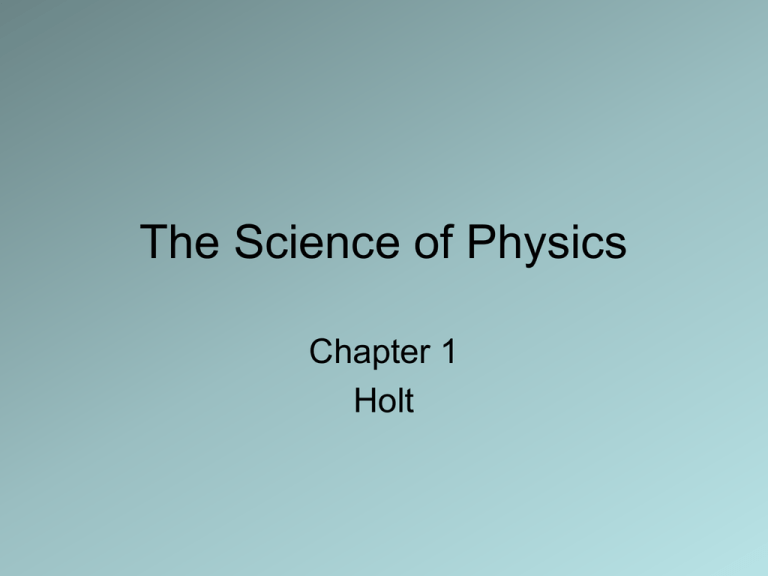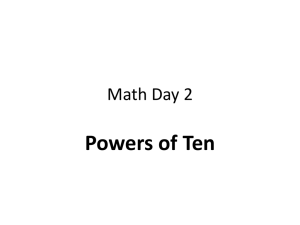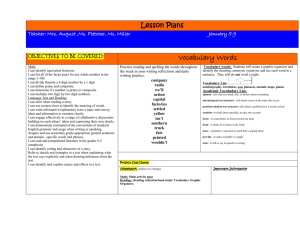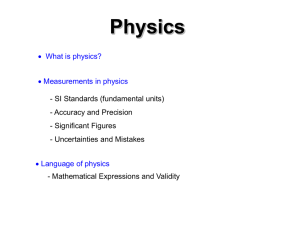
The Science of Physics
Chapter 1
Holt
1.1 What Is Physics?
• Physics is the scientific study of matter and
energy and how they interact with each other.
• This energy can take the form of motion, light,
electricity, radiation, gravity . . . Physics deals
with matter on scales ranging from sub-atomic
particles to stars and even entire galaxies.
• The goal of physics is to use a small number of
basic concepts, equations, and assumptions
to describe the physical world.
1.1 Areas Within Physics
Chapter 1
Section 1 What Is Physics?
Physics and Technology
1.1 What Is Physics?
• The scientific method is a logical approach
to solving problems.
• A set of particles or interacting components
considered to be a distinct physical entity for
the purpose of study is called a system.
•
A hypothesis is an explanation based on
prior scientific research or observations that
can be tested. A hypothesis is not a
question.
• The process of simplifying and modeling a
situation can help you determine the relevant
variables and identify a hypothesis for
testing.
1.2 Measurements in Experiments
Numbers as Measurements
• Measurements have a number and a unit! Never
assume the unit is understood; always write the
unit.
• The unit tells us two things about a number:
1)Dimension or quantity measured, such as length, mass,
time, temperature, …
2) How much of the quantity is represented, such as
kilometer, meter, centimeter, millimeter, nanometer …
1.2 Measurements in Experiments
7 SI Base Units
Quantity
length
mass
time
temperature
amount of substance
electric current
luminous intensity
Unit
meter
kilogram
second
Kelvin
mole
ampere
candela
Abbreviation
m
kg
s
K
mol
A
cd
Each base unit describes a single dimension, such as length, mass,
or time.
1.2 Measurements in Experiments
SI Standards
Derived units are formed by combining the seven base units with
multiplication or division.
Units for velocity, force, momentum, energy, volume, and acceleration are
derived from these three base units. For example, 1 Newton = 1 kg.m/s2.
Chapter 1
Section 2 Measurements in
Experiments
Numbers as Measurements
Chapter 1
Volume
1 dm3 =1 L
1 cm3 = 1 mL = 1 cc
Section 2 Measurements in
Experiments
1.2 Measurements in Experiments
• SI Prefixes
In SI, units are combined with prefixes that symbolize certain
powers of 10. The most common prefixes and their symbols
are shown in the table.
1.2 Measurements in Experiments
Dimensions and Units
• Measurements of physical quantities must be expressed in units that
match the dimensions of that quantity. (Length is measured in
meters not grams.)
• In addition to having the correct dimension, measurements used in
calculations should have the same units. Convert so that units
are the same.
For example, when
determining area by
multiplying length and width,
be sure the measurements
are expressed in the same
units.
1.2 Measurements in Experiments
• SI system
– SI system - Current definitions of the SI units
– Metric System Prefixes: Unit symbols are written as normal
letters, i.e. not italicized or boldfaced.)
– Large and Small Numbers - Metric Prefixes
– Unit Conversions
• Use the definitions of the metric prefixes to determine correct
conversion factors.
1 pm = 10-12 m is an equivalent relationship
To convert m to pm multiply by
1 pm
.
10-12 m
To convert pm to m multiply by
10-12 m
1pm
.
1.2 Measurements in Experiments
Unit Conversions
• 6 003 000 pm = _________ m
6 003 000 pm x
10-12 m
= 6.003 x 10-6 m
1pm
• Convert 73.5 km/h to its equivalent in m/s.
Know: 1000m = 1km; 60s = 1 min; 60 min = 1h
km
m
73.5 h x 1000 km
1h
1 min
x 60 min x 60 s
= 20.41666666667 m/s = 20.4 m/s
1.2 Measurements in Experiments
•
p. 15 #1-5
•
Convert 60,500 cm3 to m3.
•
Convert 55 mi/h to km/h (1.6 km = 1 mi).
1.
2.
3.
4.
5.
50 mm x 1 m/1 000 000 mm = 5.0 x 10-5 m
1 ms x 1 s/1 000 000 ms = 1.0 x 10-6 s
a. 10 nm x 10-9 m/nm = 1.0 x 10-8 m
b. 1.0 x 10-8 m x 1 000 mm/m = 1.0 x 10-5 mm
c. 1.0 x 10-8 m x 1x106 mm/m = 1.0 x 10-2 mm
1.5 x 1011 m = 150 Gm = 0.15 Tm = 1.5 x 108 km
1.440 x 103 kg
1.2 Measurements in Experiments
• Accuracy and Precision
– Accuracy refers to the agreement between a measurement and the
true or correct value. Errors in measurement affect accuracy.
– Precision refers to the repeatability of measurement. It is the degree
of exactness of a set of measurements and is limited by the finest
division on the measuring instrument scale.
1.2 Measurements in Experiments
• Error (or percent error reported in lab write-ups) refers to
the disagreement between a measurement and the true
or accepted value.
• A numeric measure of confidence in a measurement or
result is known as uncertainty. A lower uncertainty
indicates greater confidence.
• Uncertainty of a measured value is an interval around
that value such that any repetition of the measurement
will produce a new result that lies within this interval.
1.2 Measurements in Experiments
1.2 Measurements in Experiments
Determine the area of the rectangle.
What would you do?
b
Rectangle
a
1.2 Uncertainty in Measurement
0
1.0 cm
b
Rectangle
a
cm
Side b is about 0.72 cm.
Estimate possible error in reading the ruler
is 0.01 cm. (Uncertainty is 0.01 cm)
Correct reading is between 0.71 and
0.73 cm
b = 0.72 + 0.01 cm
Chapter menu
Resources
Copyright © by Holt, Rinehart and Winston. All rights reserved.
1.2 Uncertainty in Measurement
0
1.0 cm
a
Rectangle
cm
Side a is about 0.50 cm.
a = 0.49 + 0.01 cm
b
Chapter menu
Resources
Copyright © by Holt, Rinehart and Winston. All rights reserved.
1.2 Uncertainty in Measurement
What is the range of uncertainty in
the area of the rectangle?
1.0 cm
0
b
Extremes:
A = 0.71 cm x 0.48 cm = 0.3408 cm2
a
A = 0.73 cm x 0.50 cm = 0.3650 cm2
The true area is somewhere between 0.3408 cm2 and 0.3650 cm2.
Average measured values of 0.72 cm and 0.49 cm give an area of
0.3528 cm2.
A good approximation of the area is 0.35 + 0.01 cm2 or just 0.35 cm2.
To report to the ten thousandths place indicates that you measured to
the nearest ten thousandths cm. In our case the third and fourth
decimal places have no meaning.
Chapter menu
Resources
Copyright © by Holt, Rinehart and Winston. All rights reserved.
1.2 Measurements in Experiments
A metal rod about 4 inches long has been passed around
to several groups of students. Each group is asked to
measure the length of the rod. Each group has five
students and each student independently measures the
rod and records his or her result.
http://scidiv.bcc.ctc.edu/Physics/measure&sigfigs/B-Acc-Prec-Unc.html
1.2 Measurements in Experiments
Student
Group
Student 1 Student 2 Student 3 Student 4 Student 5 Average Scatter
10.2
1.2
10.155
10.146
.216
12.14
12.18
12.16
0.03
8.01
11.5
10.77
10.23
3.49
10
10
10
10
1
Group A
10.1
10.4
9.6
9.9
10.8
Group B
10.135
10.227
10.201
10.011
Group C
12.14
12.17
12.15
Group D
10.05
10.82
Group E
10
11
•
•
•
•
Which group has the most accurate measurement? Unknown
Which group has the most precise measurement? C
Which group has the greatest error?
Unknown
Which group has the greatest uncertainty?
D
1.2 Measurements in Experiments
• We now receive a report from the machine shop
where the rod was manufactured. This very
reputable firm certifies the rod to be 4 inches long to
the nearest thousandths of an inch. Answer the
questions below given this new information. Note
that the questions are slightly different.
(4.000 inches = 10.160 cm)
1.2 Measurements in Experiments
(4.000 inches = 10.160 cm)
Student
Group
Student 1 Student 2 Student 3 Student 4 Student 5
Group A
10.1
10.4
9.6
9.9
10.8
Group B
10.135
10.227
10.201
10.011
10.155
Group C
12.14
12.17
12.15
12.14
12.18
Group D
10.05
10.82
8.01
11.5
10.77
Group E
10
11
10
10
10
• Which group has the least accurate measurement?
C
• Which group has the least precise measurement?
D
• Which group has the smallest error?
A (Average is closest to accepted value.)
• Which group has the smallest uncertainty?
C
1.2 Measurements in Experiments
•
Significant Figures
–
It is important to record the precision of your
measurements so that other people can
understand and interpret your results.
–
A common convention used in science to indicate
precision is known as significant figures.
–
Significant figures are those digits in a
measurement that are known with certainty plus
the first digit that is uncertain.
1.2 Measurements in Experiments
Significant Figures
Even though this ruler is
marked in only
centimeters and halfcentimeters, you can
estimate and use it to
report measurements to
a precision of a
millimeter (1/10 of a
centimeter).
1.2 Measurements in Experiments
•
Significant Figures
–
Non-zero digits are always significant.
62.5
34.996
–
Any zeros between two significant digits are significant.
304
2 004
0.003 040
–
3 s.f.
5 s.f.
3 s.f.
4 s.f.
4 s.f.
A final zero or trailing zeros in the decimal portion
ONLY are significant.
3 200
3.20 x 103
204.06110
2 s.f.
3 s.f.
8 s.f.
1.2 Measurements in Experiments
•
Significant Figures
What is the precision for each of the following
measurements? How many significant figures are in each
measurement?
a)
b)
c)
d)
e)
f)
g)
62.5 m
34.996 m
304 m
0.003 040 m
1 200 m
3.20 x 103 m
204.061 m
tenths place 3 s.f.
thousandths of a meter 5 s.f.
one meter 3 s.f.
millionth of a meter 4 s.f.
nearest 100 meter 2 s.f.
nearest 10 meter
3 s.f.
hundred thousandths of a meter, 6 s.f.
Which measurement(s) has the greatest uncertainty? e
Which measurement(s) has the least precision? e
Which measurement(s) has the greatest precision? d
1.2 Measurements in Experiments
Scientific Notation
Scientific notation shows only the significant figures.
202000 = 2.02 x 105
0.00001023900 = 1.023900 x 10-5
1.2 Measurements in Experiments
• Answers obtained from calculations must be rounded to indicate the
correct number of significant figures.
Rule
Example
If the digit immediately to the right of the last significant
figure you want to retain is
Greater than 5, increase the last digit by 1.
56.87 g --> 56.9 g
Less than 5, do not change the last digit.
12.02 L --> 12.0 L
5, followed by nonzero digit(s), increase the last digit by 1.
3.7851 --> 3.79
5, not followed by a nonzero digit and preceded by odd
digit(s), increase the last digit by 1.
2.835 s --> 2.84 s
5, not followed by nonzero digit(s), and the preceding
significant digit is even, do not change the last digit.
2.650 mL --> 2.6 mL
1.2 Measurements in Experiments
Rounding Addition/Subtraction: :
• The answer must have its last significant
figure in the same decimal place as the
measurement with the most uncertainty.
• EX: 25.1 g + 2.03 g = 27.13 g
Answer: 27.1 g
• EX: 126 cm + 9.45 cm = 135.45 cm
Answer: 135 cm
1.2 Measurements in Experiments
Multiplication/Division: the answer can have no
more significant figures than are in the
measurement with the fewest number of significant
figures
Ex: Calculating density
D = 3.05 g / 8.47 mL
D = 0.360094451 g /mL
Answer: 0.360 g/mL
Conversion Factors do not limit the number of
significant figures shown in the final answer
1.2 Measurements in Experiments
• You will often use the results of one calculation as one of
the values in a subsequent calculation. That answer may
then be used in yet another calculation and so on.
• Repeated rounding at each step can introduce errors
that would not occur if you combined all of the steps
algebraically and computed the final result all at once.
• http://shazam.econ.ubc.ca/intro/round.htm
Practice
• p. 20 1, 3, and 4
1.3 The Language of Physics
Mathematics and Physics
• Tables, graphs, and equations can make data easier to
understand.
– In this experiment, a table-tennis ball and a golf ball are
dropped in a vacuum.
Trends??
Data from Dropped-Ball Experiment
A clear trend can be seen in the data. The more time that
passes after each ball is dropped, the farther the ball falls.
Graph from Dropped-Ball Experiment
One method for analyzing the data is to construct a
graph of the distance the balls have fallen versus the
elapsed time since they were released.
The shape of
the graph
provides
information
about the
relationship
between time
and distance.
Chapter 1:3 The Language of Physics
Interpreting Graphs
Linear Relationship
y = mx + b
Direct Proportion
y = mx
Chapter 1
Section 3 The Language of
Physics
Interpreting Graphs
Inverse Proportion
y = k(1/x)
Inverse Square Relationship
y = k(1/x2)
Chapter 1
Section 3 The Language of
Physics
Interpreting Graphs
y varies with x2
y = ax2
1.3 The Language of Physics
• Graphs
t = k/p
•
the time a SCUBA tank lasts at various
pressures
y = kx2
1.3 The Language of Physics
• Dimensional analysis can weed out invalid
equations. (Watch your units!)
– Calculate the time is will take a person to
travel 240 km if their average speed is 80
km/h.
distance/time x distance = distance2/time = time
240 km x 80 km/h
240 km x h/80 km = 3 h
1.3 The Language of Physics
Practice
1. E = mc2 What are the units for c if E is kg.m2/s2 and
m is kg?
2. In what units would a be reported? vf and vo have
units of m/s
a = (vf - vo)/Dt
3. If a is acceleration (m/s2 ), Dv is change in velocity
(m/s), Dx is change in position (m), and Dt is the time
interval (s), which equation is dimensionally correct?
a. Dt = Dx v
b. a = v Dx
c. Dv = a Dt
d. Dt = Dx2 a
1.3 The Language of Physics
• p. 25 1, 2, 4, and 5
1.3 The Language of Physics
• p. 25 2
a. kg. m/s2
b. kg. m/s3
c. kg .m2/s3
d. kg.m/s2









